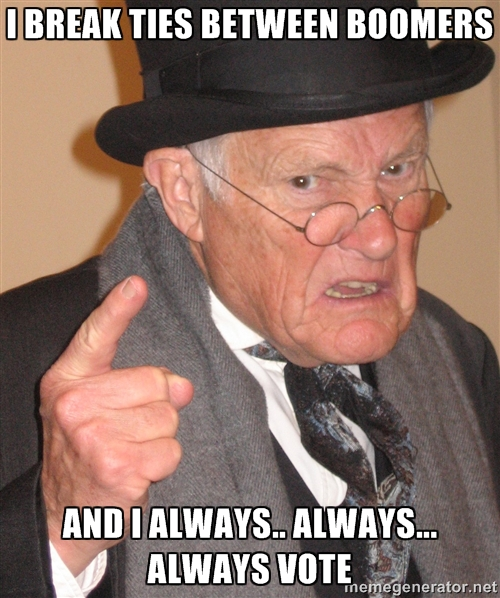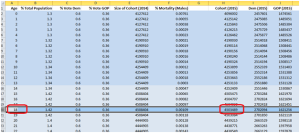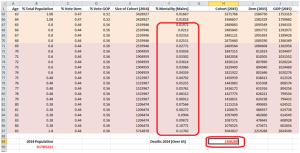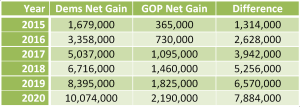Demographic Changes – The Rise of a Progressive Titan
Are you angry that the Democrats were beaten in the midterms? If you are, the number you need to repeat every day is “3,600”. I will explain.
The recent elections are a generational struggle between the Silent or “Lucky Few” generation and the Millennial generation. It isn’t unusual to place the blame squarely at the feet of the massive Baby Boomer generation but that cohort has been reliably split between the two parties. The Boomers display a slight Democratic preference offset by a larger degree of racial intolerance than the younger generations. By contrast, the older Silent generation is staunchly Republican and much more racially intolerant than any other generational group still capable of forming a voting bloc. They are even more Republican than their predecessors, the Greatest generation.
“The demographics race we’re losing badly,” Sen. Lindsey Graham (R-SC) told the Washington Post. “We’re not generating enough angry white guys to stay in business for the long term.”
Boomers and Xers
The Boomers are so split that they largely negate themselves. When the Boomers agree they make a big difference but they often don’t. The Gen-Xers skew slightly in favor of the Democrats but not enough to outweigh the conservative half of the Boomer cohort married to the monolithic conservatism of the Silents.
The Young Challengers
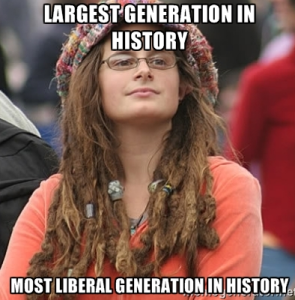
Millennials are the largest generation numbering at 95 million compared to 78 million for the Baby Boomers.
The Millennials are the largest generation in history, the most racially diverse and tolerant, and also the most liberal. They have been very unlucky economically and are taking repeated punches as they try to establish themselves in the world. They have enormous student loans, no acquired capital, delay marriage, delay children, and cannot afford a house. The youngest Millennials are about 14 years old in 2014 and by 2018 they will all be eligible to vote.
The Reigning Champions
On the other side, the Silent generation has earned the moniker “The Lucky Few”. They have enjoyed a series of wonderful advantages in their lifetimes which ensured they were largely debt free, owned a home, and could comfortably retire. As a cohort it makes some sense that this generation feels like you should be able to work your way out of poverty because their unique economic environment made this almost universally possible. The Silents range in age from about 70 years old to about 86 with a median age of about 80.
This lays out an interesting struggle between the very liberal Millennials and the very conservative Silent generation. What it also tells us is that the struggle between Silents and Millennials has an expiration date measured by the life expectancy of the Silents. Using birth rates and mortality tables we can begin to lay out the pattern that will guide the next major shift in American politics.
I did some math…
I created a model of the US population consisting of approximately 300,000,000 people. I divided that group up into birth-year groups and applied percentages from the following source using 2012 data to find the size of the population for each year:
To these single-year groups I then used demographic information from the 2012 presidential election to assign age-based voting patterns.
Once I had the groups, I applied 2009 CDC mortality statistics to each year-group to find projected numbers for new voters and the deceased voters. (By using only male mortality numbers, I skew the results towards the GOP by assuming women die at the same rate. This is untrue but it provides the GOP a bit of an edge in the final calculation.)
What did I find?
Using the 2012 presidential election results combined with the CDC data we can predict which voters will be born and which will die.
4,503,489 New Voters / 365 days = 12,338 new voters per day
On any given day about 12,000 young people turn 18 years of age and are eligible to vote. (By rounding down to 12,000, I skew the results towards the GOP. In reality, the number of new voters will likely be higher.)
New Voters Turning 18:
- D – The Millennials will add about 7,200 Democratic voters per day. (60%)
- R – The Millennials will add about 4,300 Republican voters per day. (36%)
On the other side of the equation when considering only the population over 65 about 6,000 people die every day.
The circled value of 2,308,289 deaths is calculated by applying the yearly mortality rate provided from the CDC to project a smaller group of 2015 survivors. By subtracting column H from column E we attain the number of deceased votes in the 65 or older group.
2,308,289 deaths / 365 days = 6,324 deaths per day
By rounding this number down to 6,000 deaths per day in the over 65 group we again provide conservative voters a slight advantage in the final calculation. The actual number of deaths each day will probably be higher.
Deaths:
- D – This results in 2,600 Democratic voters removed from the voting population per day. (44%)
- R – This results in 3,300 Republican voters removed from the voting population per day. (56%)
Net Gains:
New – Removed = Net Gain
D: 7,200 – 2,600 = 4,600
R: 4,300 – 3,300 = 1,000
- D – 4,600 added Democrats per day (net gain)
- R – 1,000 added Republicans per day (net gain)
Democrats are out-pacing Republican growth by a margin of almost 5-to-1.
Each and every day the Democrats gain a net advantage of 3,600 voters. It will take some time for the trend to become dominant but it amounts to 1,314,000 new net Democratic votes each year. Presidential elections will likely be dominated by the growing power of the Millennial vote but midterms will still skew older. That will result in a pendular effect from election to election. By the time the youngest of the Silent voters reach 77 in 2020, well over half of the Silent generation will be deceased. By 2024 about 66% of the youngest Silents will be deceased.
If we held these trends artificially steady from 2015 until 2020 we would see:
Final Thoughts
- The country is creating new Democratic voters much faster than new Republican ones. (Almost 2-to-1.)
- The concentration of Republicans in the Silent Generation mean the GOP loses voters much faster than Democrats. (About 2-to-3.)
- The rate of increase in Democratic voters is almost 5-to-1.
- In 2012 Obama won the popular election by less than 5,000,000 votes.
- In 3 years the Millennials will add over 5,000,000 new Democratic leaning voters to the population.
- In 4 years the Millennials will create a more than 5,000,000 vote advantage over the GOP.
The finding is that the Republican party is being eaten away from both sides by the demographic changes. My estimations are actually a best case for the GOP and these trends should accelerate rather than progress linearly as I show above.
As an example, if the average age of a Fox News viewer is 68, about half of those viewers will pass away in the next 14 years and their likelihood of dying increases each year along an exponential curve. Other considerations are that red states typically have life expectancies 1-3 years lower than blue states and men are more likely to be conservative than women but have life expectancies 2-3 years shorter.
At a glance the 2016 presidential election should draw wide turnout across all generations and it seems like the Democrat’s election to lose. The more interesting election may be the 2018 midterm because it provides us a metric to measure the decline of the Silent generation’s voting bloc just as the Millennials begin to realize their generation’s political power.
Consider the difference in the behavior of the Senate when one party holds a super-majority over the other. As an analogy that has been the racial reality in the United States for its entire history thus far. The racially white super-majority population in the United States is vanishing and it will also change how America governs. Whites will no longer be able to dictate governance to a nearly powerless collection of minorities. This terrifies many older Americans but for the Millennials this is already their demographic experience.
To paraphrase Fox’s Megyn Kelly, this number-crunching is clearly math that liberals will do to make themselves feel better after a bad midterm. Even so, the math appears to be sound. That new liberal power-house is measurable at 3,600 more liberal votes per day and growing.
More details about the gaps between the current generations can be found here:


